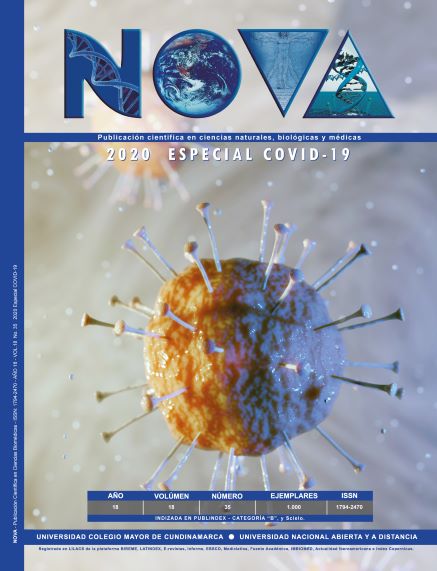COVID-19 infection, a look at environmental factors related to the pandemic
Infección por COVID-19, una mirada a los factores ambientales relacionados con la pandemia
NOVA by http://www.unicolmayor.edu.co/publicaciones/index.php/nova is distributed under a license creative commons non comertial-atribution-withoutderive 4.0 international.
Furthermore, the authors keep their property intellectual rights over the articles.
Show authors biography
The global pandemic due to COVID-19 has generated countless alerts and changes in the ways of living and consuming, the environment, health and individual triad is once again the protagonist in this scenario where serious fractures in the public health systems, habitat and food security are seen. As a transverse factor to these elements, environmental contamination became a facilitating effect of the pandemic and transmission by contact between humans through aerosols represents the route of contagion, this situation forced the distancing and preventive confinement, this measure to makes evident the poverty, inequality and inequity that is experienced globally, on the other hand the changes in mobility and the frequency of production in manufacturing industries brought a reduction in greenhouse gases.
Article visits 578 | PDF visits 289
Downloads
1. Zhao M, Wang M, Zhang J, Ye J, Xu Y, Wang Z, et al. Advances in the relationship between coronavirus infection and cardiovascular diseases. Biomedicine & Pharmacotherapy. 2020;127:110230.
2. Horne BD, Joy EA, Hofmann MG, Gesteland PH, Cannon JB, Lefler JS, et al. Short-Term Elevation of Fine Particulate Matter Air Pollution and Acute Lower Respiratory Infection. American Journal of Respiratory and Critical Care Medicine. 2018;198(6):759-66
3. Friedlingstein P, Jones MW, O'sullivan M, Andrew RM, Hauck J, Peters GP, et al. Global Carbon Budget 2019. Earth System Science Data. 2019;11(4):1783-838.
4. Gorr MW, Falvo MJ, Wold LE. Air Pollution and Other Environmental Modulators of Cardiac Function. Comprehensive Physiology. 2017;1479-95
5. Koton S, Molshatzki N, Yuval, Myers V, Broday DM, Drory Y, et al. Cumulative exposure to particulate matter air pollution and long-term post-myocardial infarction outcomes. Preventive Medicine. 2013;57(4):339-44.
6. D’Ippoliti D, Forastiere F, Ancona C, Agabiti N, Fusco D, Michelozzi P, et al. Air Pollution and Myocardial Infarction in Rome. Epidemiology. 2003;14(5):528-35.
7. Eslami H, Jalili M. The role of environmental factors to transmission of SARS-CoV-2 (COVID-19). AMB Express. 2020;10(1).
8. Abdullahi, Idris Nasir et al. “Exploring the genetics, ecology of SARS-COV-2 and climatic factors as possible control strategies against COVID-19.” Le infezioni in medicina. 2020; 28(2):166-173.
9. Chin A, Chu J, Perera M, Hui K, Yen H-L, Chan M, Peiris M, Poon L. Stability of SARS-CoV-2 in different environmental conditions. medRxiv. 2020 doi: 10.1101/2020.03.15.20036673.
10. FAO.La seguridad alimentaria y la nutrición en el mundo en 2018. El estado de la seguridad alimentaria y la nutrición en el mundo El estado de la seguridad alimentaria y la nutrición en el mundo 2018. 2019;1-36.
11. Almonacid C, Hernández E, Rosas M, Triana V, y García N.Y Determinación del riesgo cardiovascular y su asociación con la presencia de dislipemias en universitarios de Bogotá-Colombia. Rev Esp Cardiol. 2016:69 Supl 1:5
12. Muhammad S, Long X, Salman M. COVID-19 pandemic and environmental pollution: A blessing in disguise? Science of The Total Environment. 2020;728:138820.
13. Barcelo D. An environmental and health perspective for COVID-19 outbreak: Meteorology and air quality influence, sewage epidemiology indicator, hospitals disinfection, drug therapies and recommendations. Journal of Environmental Chemical Engineering. 2020;8(4):104006.






